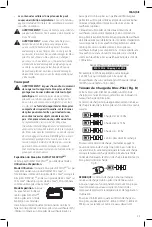
English
10
tool. This can seriously affect the life and performance
of the tool.
nOTE:
The battery pack is not fully charged out of the
carton. Follow instructions outlined (refer to
Charging
A Battery
).
1. Read the
Nailer Safety Warnings
section of
this manual.
2. Wear eye and ear protection.
3. Remove battery from tool.
4. Ensure magazine is empty of all fastners.
5. Check for smooth and proper operation of contact
trip and pusher assemblies. Do not use tool if either
assembly is not functioning properly.
nEVER
use
a tool that has the contact trip restrained in the
actuated position.
6. Keep tool pointed away from yourself and others.
7. Insert fully charged battery pack.
Using the Trigger Lock-off (Fig. F)
WARNING:
To reduce the risk of serious personal
injury, do not keep trigger depressed when tool is not
in use. Keep the trigger lock-off switch LOCKED (Fig. F)
when the tool is not in use.
WARNING:
To reduce the risk of serious personal
injury, lock off trigger, disconnect battery pack
from tool and remove pins from magazine before
making adjustments.
Each
D
e
WALT
nailer is equipped with a trigger lock-off
2
which when pushed to the right as shown in Figure F,
prevents the tool from firing a pin by locking the trigger and
bypassing power to the motor.
Fig. F
2
When the trigger lock-off is pressed to the left, the tool will
be fully operational. The trigger lock-off should always be
locked off whenever any adjustments are made or when
tool is not in immediate use.
NOTICE:
Do not store tool with battery pack installed.
To prevent damage to the pack and to ensure best
battery life, store battery packs out of the tool or
charger in a cool, dry location.
Loading the Tool (Fig. G)
WARNING:
Keep the tool pointed away from yourself
and others.
WARNING:
Never load pins with the contact trip or
trigger activated.
WARNING:
Always remove battery pack before
loading or unloading pins.
CAUTION:
Keep fingers clear of pusher latch track to
prevent injury.
WARNING:
The trigger lock-off should always be
engaged whenever any adjustments are made or
when tool is not in use.
WARNING:
Fasteners used to install metal connectors
must meet the requirements of the applicable building
codes and must be installed in compliance with code
requirements and metal connector hardware supplier
specifications. Failure to properly install connectors
may result in structural failures.
1. Turn the nailer upside down.
2. Slide the spring-loaded pusher latch
15
to the base of
the magazine to lock it into place.
Fig. G
15
3. Drop pin strips into the loading slot of the magazine,
making sure the pin heads align correctly with the slot
opening. (Refer to
Pin Specifications
to determine
compatible size.)
4. Keeping fingers clear of the track, close the magazine by
releasing the pusher latch. Carefully allow the latch to
slide forward and engage the pin strip.
Unloading the Tool
WARNING:
The trigger lock-off should always be
locked off whenever any adjustments are made or
when tool is not in use.
1. Slide the spring-loaded pusher latch to the base of the
magazine to lock it into place.
2. Tip the tool up until the fastener strip slides freely out of
the magazine.
3. With battery removed, check the nosepiece to verify
there are no pins remaining.
nOTE:
The tool is equipped with a magnet in the nose
area for improved tool performance. When unloading,
always verify that the small sticks of pins are not held to the
magnetized nose piece.
Power Setting Summary (Fig. H, I)
This nailer is equipped with a power selection switch
3
to
adjust the tool when driving into different materials.
Power setting 1: Softer materials (low strength concrete/
cinder block)
Power setting 2: Medium hardness materials (High strength
concrete)
Power setting 3: Hard materials (Structural Steel)
In the event pins are not driving to depth in power setting 1,
you may have to switch to power 2 or 3 for additional
driving power.
Summary of Contents for DCN891
Page 59: ......













































